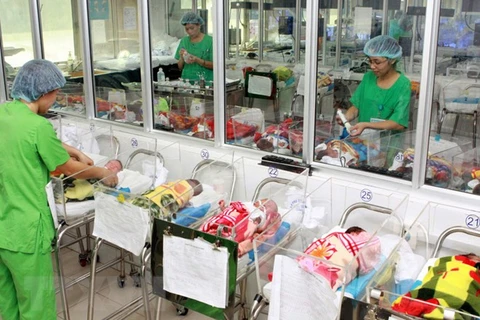 Women receive advice on reproductive health from a doctor at a hospital in Hanoi's Me Linh District. (Photo hanoimoi.com.vn)
Women receive advice on reproductive health from a doctor at a hospital in Hanoi's Me Linh District. (Photo hanoimoi.com.vn) Hanoi (VNS/VNA) - In the first nine months of this year, the sex ratio at birth in Hanoi stood at 110.5 boys to 100 girls, a decrease from 2018 when it was 113.5:100.
The city welcomed more than 78,350 newborns in the first nine months of the year, an increase of 3,935 children over the same period last year. Among them, 6,136 were at least the third child in their families, rising by 254 compared to the previous year.
Gender inequality was falling but the third-child birthrate had shown an increase, said Ta Quang Huy, director of the municipal Department of Population and Family Planning.
The country's basic policy encourages parents to have two children per family.
With a long-standing cultural preference for boys, couples who have only daughters always want a son because many believe that only sons can be responsible for worshipping their ancestors and maintaining lineage.
In fact, many Vietnamese families want to have more children, especially due to better economic conditions, so they decide to have a third child.
In many cases, these families are officials or civil servants who are familiar with the State’s policies and laws.
Dr Nguyen Dinh Cu, former director of the Population and Social Affairs Institute at the National Economics University, said for a long time, people thought that the imbalanced sex ratio at birth was mainly due to poor and uneducated mothers, but in fact, this is not true.
Ha Noi Moi (New Hanoi) newspaper reported that recent census results conducted by the General Department of Population and Family Planning at the Ministry of Health showed the lowest sex ratio at birth among illiterate mothers was about 107 boys per 100 girls.
This rate gradually increases to 114 boys per 100 girls among more educated mothers. In rich families, the sex ratio at birth is 112:100, while the rate in poor families is 105:100.
Appreciating the achievements of the city's population and family planning efforts over the years, yet Dr Hoang Duc Hanh, deputy director of the municipal Health Department, said it was necessary to continue implementing measures to control the gender imbalance, particularly the third-child birthrate.
Raising awareness of the problem and changing public attitudes was also needed to ensure families only had two children, he said. Supervision at all levels regarding the sex selection at health facilities, especially non-public health facilities, should also be strengthened.
The municipal Department of Population and Family Planning would continue to focus on communication campaigns, counselling and direct dialogue with couples of reproductive age, while supplying contraceptives, according to Huy./.
VNA























